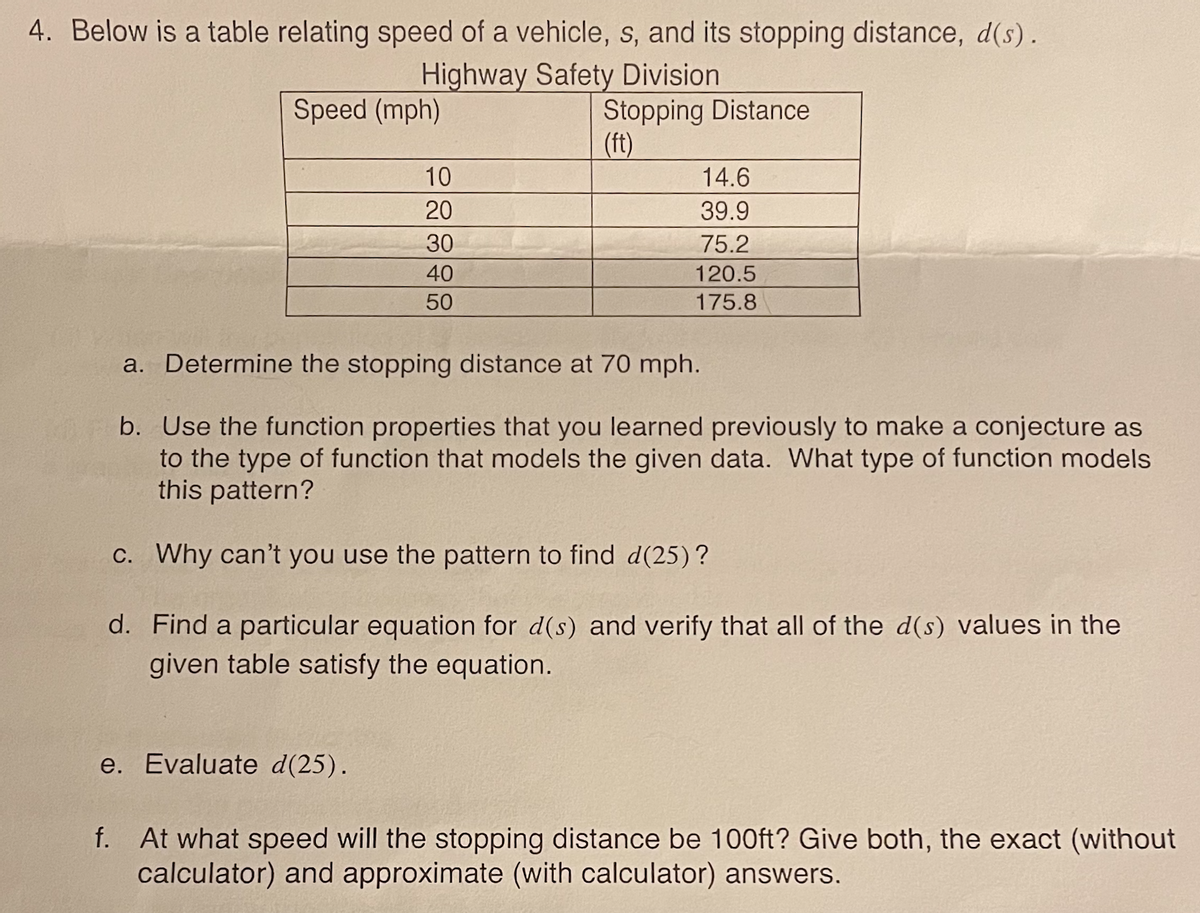4. Below is a table relating speed of a vehicle, s, and its stopping distance, d(s). Highway Safety Division Stopping Distance (ft) Speed (mph) 10 14.6 20 39.9 30 75.2 40 120.5 50 175.8 a. Determine the stopping distance at 70 mph. b. Use the function properties that you learned previously to make a conjecture as to the type of function that models the given data. What type of function models this pattern? C. Why can't you use the pattern to find d(25)? d. Find a particular equation for d(s) and verify that all of the d(s) values in the given table satisfy the equation. e. Evaluate d(25). f. At what speed will the stopping distance be 100ft? Give both, the exact (without calculator) and approximate (with calculator) answers.
4. Below is a table relating speed of a vehicle, s, and its stopping distance, d(s). Highway Safety Division Stopping Distance (ft) Speed (mph) 10 14.6 20 39.9 30 75.2 40 120.5 50 175.8 a. Determine the stopping distance at 70 mph. b. Use the function properties that you learned previously to make a conjecture as to the type of function that models the given data. What type of function models this pattern? C. Why can't you use the pattern to find d(25)? d. Find a particular equation for d(s) and verify that all of the d(s) values in the given table satisfy the equation. e. Evaluate d(25). f. At what speed will the stopping distance be 100ft? Give both, the exact (without calculator) and approximate (with calculator) answers.
Calculus: Early Transcendentals
8th Edition
ISBN:9781285741550
Author:James Stewart
Publisher:James Stewart
Chapter1: Functions And Models
Section: Chapter Questions
Problem 1RCC: (a) What is a function? What are its domain and range? (b) What is the graph of a function? (c) How...
Related questions
Question
100%
I need help being walked through the logistic growth problem that is in the image attached please :)

Transcribed Image Text:4. Below is a table relating speed of a vehicle, s, and its stopping distance, d(s).
Highway Safety Division
Stopping Distance
(ft)
Speed (mph)
10
14.6
20
39.9
30
75.2
40
120.5
50
175.8
a. Determine the stopping distance at 70 mph.
b. Use the function properties that you learned previously to make a conjecture as
to the type of function that models the given data. What type of function models
this pattern?
C. Why can't you use the pattern to find d(25)?
d. Find a particular equation for d(s) and verify that all of the d(s) values in the
given table satisfy the equation.
e. Evaluate d(25).
f. At what speed will the stopping distance be 100ft? Give both, the exact (without
calculator) and approximate (with calculator) answers.
Expert Solution
This question has been solved!
Explore an expertly crafted, step-by-step solution for a thorough understanding of key concepts.
Step by step
Solved in 2 steps with 2 images

Recommended textbooks for you

Calculus: Early Transcendentals
Calculus
ISBN:
9781285741550
Author:
James Stewart
Publisher:
Cengage Learning

Thomas' Calculus (14th Edition)
Calculus
ISBN:
9780134438986
Author:
Joel R. Hass, Christopher E. Heil, Maurice D. Weir
Publisher:
PEARSON

Calculus: Early Transcendentals (3rd Edition)
Calculus
ISBN:
9780134763644
Author:
William L. Briggs, Lyle Cochran, Bernard Gillett, Eric Schulz
Publisher:
PEARSON

Calculus: Early Transcendentals
Calculus
ISBN:
9781285741550
Author:
James Stewart
Publisher:
Cengage Learning

Thomas' Calculus (14th Edition)
Calculus
ISBN:
9780134438986
Author:
Joel R. Hass, Christopher E. Heil, Maurice D. Weir
Publisher:
PEARSON

Calculus: Early Transcendentals (3rd Edition)
Calculus
ISBN:
9780134763644
Author:
William L. Briggs, Lyle Cochran, Bernard Gillett, Eric Schulz
Publisher:
PEARSON

Calculus: Early Transcendentals
Calculus
ISBN:
9781319050740
Author:
Jon Rogawski, Colin Adams, Robert Franzosa
Publisher:
W. H. Freeman


Calculus: Early Transcendental Functions
Calculus
ISBN:
9781337552516
Author:
Ron Larson, Bruce H. Edwards
Publisher:
Cengage Learning